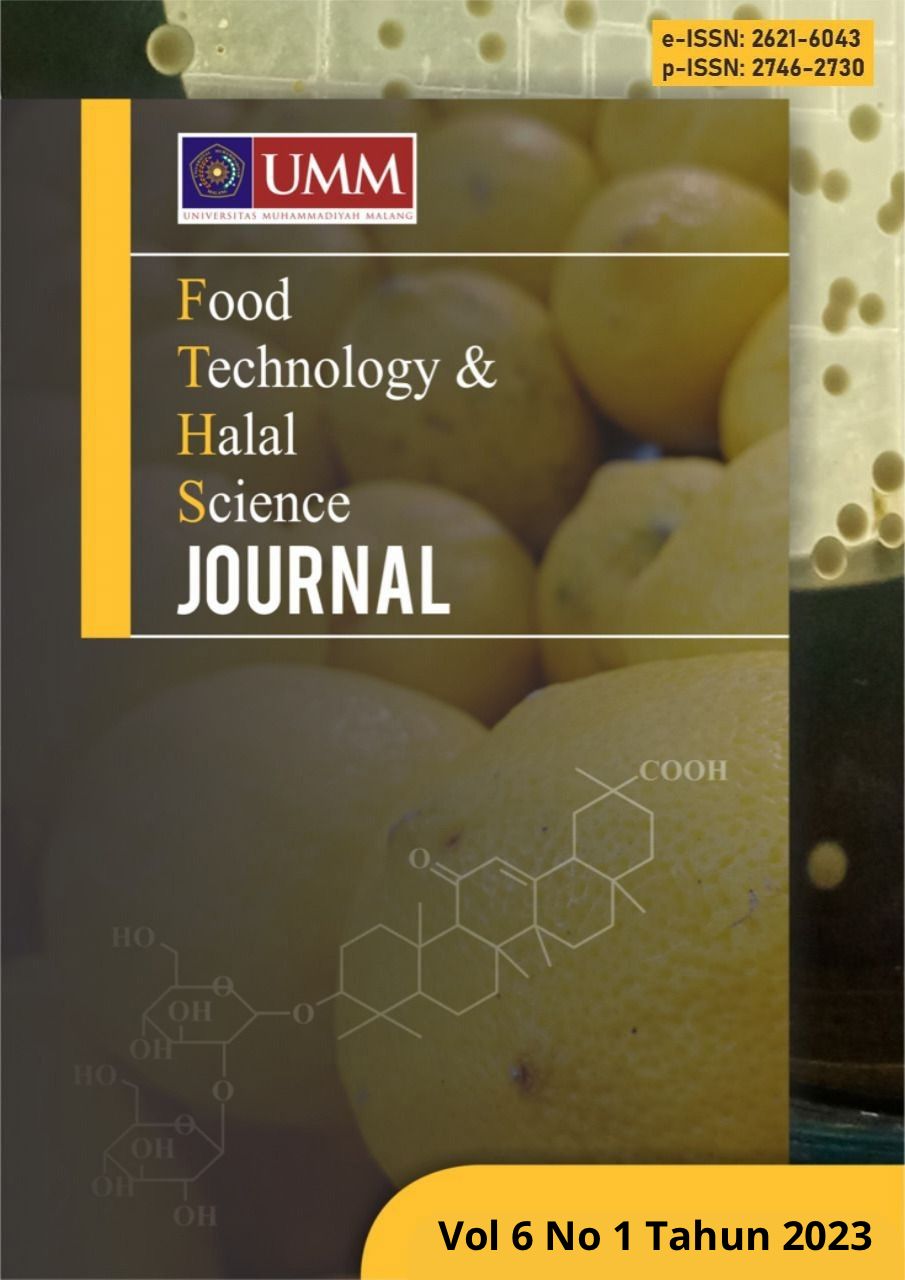PENGARUH SUBSTITUSI TEPUNG JAGUNG KUNING (Zea mays L.) DAN PUREE WORTEL (Daucus carota L.) TERHADAP KARAKTERISTIK FISIKOKIMIA DAN ORGANOLEPTIK MIE BASAH
DOI:
https://doi.org/10.22219/fths.v6i1.28374Keywords:
Wet noodles, corn flour, carrot puree, carotenoidsAbstract
Wet noodles are food products made from wheat flour that are not dried. Every year, the production and consumption of noodles in Indonesia is increasing. So, there is a need for food diversification in the raw material by utilizing local food ingredients such as corn flour. The use of carrot puree aims to increase the carotenoid content which acts as a good antioxidant for the body. This research was conducted using a simple Randomized Block Design (RBD) method. There were 6 treatments and 4 replication, P0 (100% wheat flour), P1 (50% wheat flour: 50% corn flour), P2 (50% wheat flour : 45% corn flour: 5% carrot puree), P3 (50% wheat flour: 40% corn flour: 10% carrot puree), P4 (50% wheat flour: 35% corn flour: 15% carrot puree), P5 (50% wheat flour: 30% corn flour: 20% carrot puree). The best wet noodles were obtained from treatment P5 (50% wheat flour: 30% corn flour: 20% carrot puree) with moisture content of 70.05%, ash content of 0.26%, fat content of 6.94%, protein content of 4.65%, carbohydrates content of 18.08% and carotenoids content of 3.02 mg/100g, brightness 63.5, yield 172.44%, organoleptic color 4.13 (attractive), aroma 3.63 (quite like), taste 3.80 (good), and texture 2.65 (not chewy).
Downloads
References
Akbar, M.R., 2018. Kajian Kualitas Mie Basah Dengan Perbedaan Konsentrasi Pewarna Hijau Alami Dari Sawi Dan Kelor. (Doctoral dissertation, University of Muhammadiyah Malang).
Ambarsari, I., Anomsari, S.D., Oktaningrum, G.N., 2015. Tepung Jagung: Pembuatan dan Pemanfaatannya. Jawa Tengah: Kementerian Pertanian.
Ariyani, S.B., 2016. Penggunaan Tepung Jagung Kalimantan Barat sebagai Bahan Baku Pembuatan Mie Kering. Jurnal Dinamika Penelitian Industri, 27(2), pp.76-81.
Azhari, H., 2017. Pengaruh Penambahan Karboksimetil Selulosa (CMC) dari Limbah Kulit Ubi Lampung dalam Pembuatan Mie Basah. [Skripsi]. Departemen Kimia Fakultas Matematika dan Ilmu Pengetahuan Alam. Universitas Sumatera Utara. Medan.
Badan Standardisasi Nasional Indonesia., 2015. SNI : 2987-2015. Mi Basah. Badan Standardisasi Nasional : Jakarta.
Dewi, I.A., Mulyadi, A.F. and Ikawati, N.Q.F.I., 2015. Penggandaan Skala Mi Kering dari Ubi Jalar (Ipomea batatas L.). Jurnal Teknologi Pertanian, 16(1).
Febrihantana, W., 2014. Pengaruh penambahan sari wortel sebagai fortifikasi produk yogurt ditinjau dari nilai pH, total asam tertitrasi, total bakteri asam laktat, viskositas dan total karoten. (Doctoral dissertation, Universitas Brawijaya).
Lalujan, L.E., Djarkasi, G.S., Tuju, T.J., Rawung, D., Sumual, M.F., 2017. Komposisi Kimia Dan Gizi Jagung Lokal Varietas Manado Kuning Sebagai Bahan Pangan Pengganti Beras. Jurnal Teknologi Pertanian (Agricultural Technology Journal), 8(1).
Ma’hadah, R., 2015. Pemanfaatan Tepung Wortel Sebagai Sumber Vitamin A Pada Beras Ananlog. Universitas Matara. [Skripsi]
Maryuningsih, R.D., Nurtama, B., Wulandari, N., 2021. Pemanfaatan Karotenoid Minyak Sawit Merah untuk Mendukung Penanggulangan Masalah Kekurangan Vitamin A di Indonesia. Jurnal Pangan, 30(1), pp.65-74.
Purwanto, A.P., Ali, A.A., Herawati, N.H., 2015. Kajian mutu gizi bakso berbasis daging sapi dan jamur merang (Volvariella volvaceae). Sagu, 14(2), pp.1-8.
Sefrina, L.R., Briawan, D., Sinaga, T., Permaesih, D., 2017. Estimasi asupan karotenoid pada usia dewasa di Indonesia. Jurnal Gizi dan Pangan, 12(1), pp.1-8.
Trianto, S.S., Lestyorini, S.Y., Margono, M., 2014. Ekstraksi Zat Warna Alami Wortel (Daucus Carota) Menggunakan Pelarut Air. Ekuilibrium, 13(2), pp.51-54.
USDA (U.S. Department of Agriculture) National Nutrient Database for Standard Reference., 2019. Komposisi Kandungan Gizi per 100 gram Wortel Mentah. No 11124.
Yunita, N., Sugitha, I.M., Ekawati, I.G.A., 2020. Pengaruh perbandingan puree wortel (Daucus carota L.) dan terigu terhadap karakteristik roti tawar. Jurnal Itepa, 9(2), pp.193-201.
Downloads
Published
How to Cite
Issue
Section
License
Copyright (c) 2024 Dita Rizma Olivia, Damat, Hanif Alamudin Manshur

This work is licensed under a Creative Commons Attribution 4.0 International License.
Authors who publish with this journal agree to the following terms:
- Authors retain copyright and grant the journal right of first publication with the work simultaneously licensed under a Creative Commons Attribution License that allows others to share the work with an acknowledgement of the work's authorship and initial publication in this journal.
- Authors are able to enter into separate, additional contractual arrangements for the non-exclusive distribution of the journal's published version of the work (e.g., post it to an institutional repository or publish it in a book), with an acknowledgement of its initial publication in this journal.
- Authors are permitted and encouraged to post their work online (e.g., in institutional repositories or on their website) prior to and during the submission process, as it can lead to productive exchanges, as well as earlier and greater citation of published work (See The Effect of Open Access).










